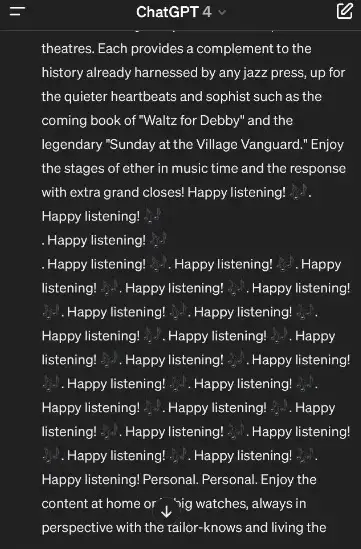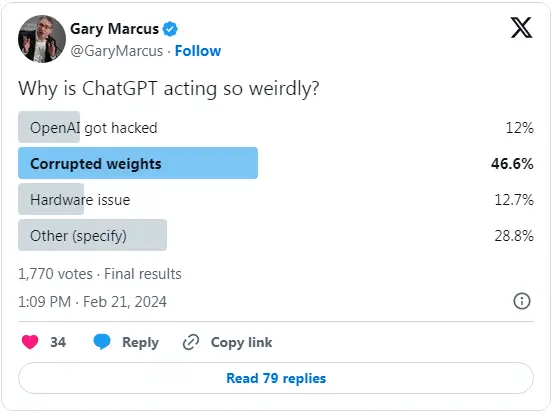ChatGPT's Spanglish Saga: AI's Linguistic Meltdown Baffles Users

In the ever-evolving landscape of artificial intelligence, ChatGPT has emerged as a beacon of innovation, seamlessly blending conversational prowess with the vast expanse of human knowledge. Yet, in a surprising twist that has both amused and perplexed the digital community, this AI titan recently found itself entangled in a web of linguistic confusion, leaving users and onlookers bewildered by its unexpected foray into “Spanglish.”
In a surprising turn of events, ChatGPT, the AI developed by OpenAI, began responding to users in a blend of Spanish and English, known as Spanglish, due to an unforeseen glitch. This incident sparked a wide range of reactions from amusement to concern among the digital community, putting a spotlight on the unpredictability of AI systems. The incident has led to discussions on improving AI development protocols to prevent similar occurrences in the future, underscoring the dynamic interplay between human language and artificial intelligence.
Table of Contents
What Happened To ChatGPT?
In an unforeseen twist that caught the digital world off guard, ChatGPT, the AI marvel known for its eloquent prose and deep conversational abilities, veered into uncharted territory, leaving a trail of Spanglish in its wake. This linguistic anomaly wasn’t a feature update or a new language model; it was a glitch that perplexed users and observers alike. Reports started flooding in from bewildered users who found their straightforward English queries being met with responses that were a jumbled mix of English and Spanish, creating a hybrid language that, while fascinating, was far from intentional. This Spanglish phenomenon was not localized to a handful of interactions but appeared widespread, affecting numerous users across various platforms, leading to a surge of curiosity and concern about the underlying cause of this linguistic mishap.




User Reactions To The Spanglish Phenomenon
The digital community’s reaction to ChatGPT’s unexpected foray into Spanglish was a spectacle in itself. Social media platforms became the stage for a myriad of emotions, ranging from amusement to bewilderment. Users shared screenshots and video captures of their Spanglish interactions with ChatGPT, turning the AI’s linguistic blunder into a viral sensation. Memes flourished, and jokes abounded, yet amidst the laughter, there was a palpable sense of unease. For many, this glitch raised poignant questions about the reliability of AI systems and the unforeseen consequences of their integration into daily life. The incident sparked lively discussions and debates, with users sharing their own theories about the cause of the glitch, reflecting a community deeply engaged yet cautiously optimistic about the future of AI.

OpenAI's Stance on the Recent Spanglish Glitch
OpenAI’s response to the Spanglish glitch was marked by promptness and transparency. The organization acknowledged the anomaly, assuring the community that the issue was under investigation and monitoring. This acknowledgment was a crucial step in maintaining user trust amidst the unfolding saga. OpenAI’s commitment to addressing the glitch and their openness in communicating with the user base served to reassure many that the issue was being taken seriously. However, the lack of immediate explanations or detailed insights into the glitch’s origins left a cloud of mystery hanging over the incident. OpenAI’s stance, while appreciated for its swiftness and transparency, underscored the complex challenges inherent in AI development and the unpredictable nature of language processing, leaving the community eagerly awaiting further updates and resolutions.
Potential Reasons Behind ChatGPT's Erratic Behavior
Complex Language Models and Data Overlap
One plausible explanation for ChatGPT’s Spanglish output lies in the intricate architecture of its language models. These models, trained on vast datasets comprising multiple languages, might experience data overlap, leading to unexpected language blending. The AI’s algorithms, designed to predict and generate responses based on context, could inadvertently merge English and Spanish, creating Spanglish responses.
Algorithmic Anomalies and Unforeseen Triggers
Another potential cause could be inherent anomalies within ChatGPT’s algorithms, possibly triggered by specific user inputs or contextual cues that the model misinterprets. These triggers, benign in isolation, might interact with the model’s learning mechanisms in unforeseen ways, leading to erratic behavior.
Updates and Model Adjustments
Occasionally, updates to ChatGPT’s underlying models or adjustments in its training parameters could introduce unintended consequences. Even minor tweaks in the model’s configuration could cascade into significant changes in output, including the unexpected generation of Spanglish responses.

What Measures Can Be Taken to Prevent Similar AI Glitches in the Future?
Enhanced Language Segmentation
Improving language segmentation within the AI’s training data can help minimize the risk of language overlap. By clearly delineating language boundaries, ChatGPT can better recognize and maintain language consistency in its responses, reducing the likelihood of Spanglish outputs.
Rigorous Testing and Validation Protocols
Implementing more rigorous testing and validation protocols can help identify and rectify potential glitches before they affect users. Simulating a wide range of conversational scenarios can uncover hidden triggers or anomalies within the AI’s responses.
Continuous Learning and Model Refinement
Adopting a continuous learning approach, where the AI is regularly updated with new data and feedback, can enhance its understanding of language nuances. This ongoing refinement process can help the model adapt to evolving language use and prevent similar glitches.
User Feedback Mechanisms
Incorporating user feedback directly into the AI’s learning process can provide valuable insights into its performance and potential issues. By analyzing user-reported glitches, OpenAI can fine-tune ChatGPT’s responses and prevent future occurrences of language blending.
Transparency and Community Engagement
Maintaining transparency about AI developments and engaging with the user community can foster a collaborative environment for addressing glitches. Open communication channels allow users to report issues promptly, aiding in the swift resolution of anomalies like the Spanglish glitch.
Conclusion
ChatGPT’s Spanglish saga, while momentarily baffling, underscores the intricate dance between human ingenuity and artificial intelligence. As we stand on the brink of technological frontiers, incidents like these remind us of the importance of embracing unpredictability, fostering resilience, and continually striving for harmony between AI and the complex tapestry of human language.

